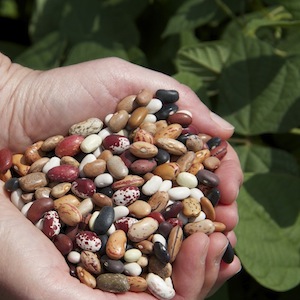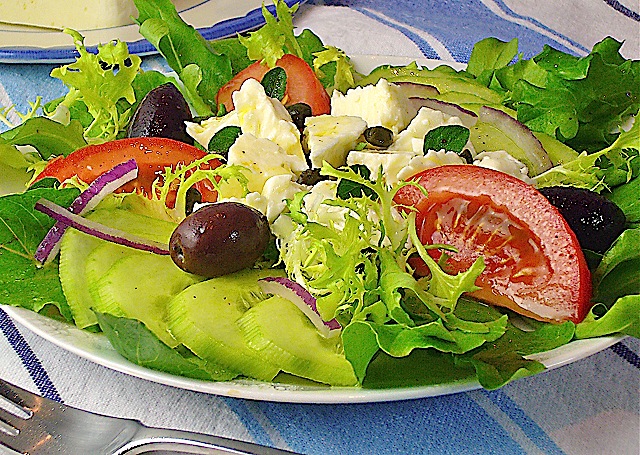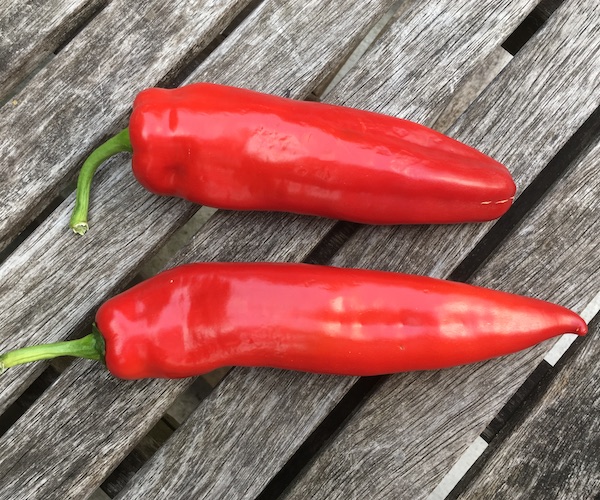
Tom Smith, Research Technician and Plant Breeder at Guelph University’s Elora Research Station in his bean fields.
The collections of farms that make up the University of Guelph’s Elora Research Station look much like their neighbours in the Southwest Ontario agricultural heartland. Except, the field I stood in with the Department of Plant Agriculture’s Tom Smith and the university’s Food Laureate, Anita Stewart, wasn’t planted with a single crop. Instead, it was a patchwork of different low lying bushes. Some were of plants with dark green leaves, others had leaves that had turned yellow. Some were higher than most, others were lower than most. All of them hung bean pods, but some pods were long, others short, some speckled, others monotone. Each patch was about 4′ by (I’m guessing) 12′, with a narrow aisle and row to walk around. Smith explained that this bean field was planted with dozens of hybrid varieties of Phaseolus vulgaris, the common bean.
Smith is proud of his and his students’ work, which is growing out of the ground around us, and he opens various pods for Stewart and I to inspect. The cross breeding at Guelph, without getting too deep into the sex life of a bean, is done the old fashioned way: there’s no GMO stuff going on. Smith and colleagues at the University of Guelph and Agriculture and Agri-Food Canada are breeding for traits like the ability to survive cold weather, or disease resistance (particularly from the very scary sounding Anthracnose. Beans make up an important part of millions, if not billions, of the worlds’ peoples’ diet, and are a growing cash crop in Ontario, and on the Canadian prairies. But, apart from the practical business of making better beans, the work manifested on the field is part of a greater project called Applied Bean Genomics and Bioproduct Development. So, while Smith and his students grow the beans and collect data on successive generations of crossess, the white coats in the laboratories back on the campus of the University of Guelph are taking those beans and studying them for the purpose of sequencing mapping the bean genome.

Yasser Qahawish receives research beans at Artisanale restaurant in Guelph. Photo: Anita Stewart.
One of those white coats is Peter Pauls, Professor and Chair of the Department of Plant Agriculture. It was on his invitation to dinner, delivered through Stewart and Lori Wright (who has the best job title ever: Phaseolus Genomics Project Manager), which brought me to the research station, and then to dinner in town. As Guelph’s Food Laureate, one of Stewart’s jobs is to connect different departments involved in food, like Management and Economics or Hospitality and Tourism Management, to the research end of the university’s agricultural programs. When she learned that Pauls was hosting a sort of mini-academic conference on Applied Bean Genomics, she suggested events conclude with a dinner for participants and a few guests from around the university and one journalist from Toronto. It wouldn’t be just any dinner. It would be cooked by the city’s top chef, Yasser Qahawish, at his restaurant Artisanale, and on the plate of every course would be a composition made with a hybrid bean harvested from local fields.
Artisanale has changed locations since I was last there two years ago. Qahawish has taken over a big old limestone house just outside of Guelph’s downtown. It’s elegant and casual in the way that great restaurants outside of big cites often are, and it reminds a bit of The French Laundry. Qahawish’s cuisine is classic French technique, rigorously applied, meets the absolute best, freshest ingredients he can find. A large part of his move to Guelph, after a successful early career in Toronto, was to be that much closer to the farmers whose foods he cooks. Our bean meal was an early sitting, right after the conference at 5 o’clock on a Wednesday night and by seven, I noticed his restaurant was full of happy looking diners.
For our Applied Bean Genomics dinner, Qahawish served three courses, each featuring a variety of bean associated with the research being done near Elora. To begin, a simple salad of ripe field tomatoes, onion and salad greens bolstered by croutons and simply dressed Red Rider beans. The Red Rider is a Romano or ‘cranberry’ bean variety, bred to mature in time with the Ontario climate. The beans worked very well with the sweet and slightly tart tomatoes, and version of this dish would make a lovely lunch on its’ own. All plates were quickly cleared. The Second dish was lamb shoulder, roasted perfectly pink and served in a herbal jus, with just picked zucchini and a side of delicate Rexeter beans. Rexeter is a variety of navy or white beans, bred for high yield and resistance to Common Bacterial Blight. The pairing of navy bean to lamb was a classic French touch, and the starchy beans greedily soaked up the salty jus. This was a definite crowd pleaser. Last came a fusion of French and Japanese dessert traditions: half a white Niagara peach, poached and swimming in crème Anglaise, and surrounded by candied AC Calmont beans. AC Calmont is a red kidney bean variety, bred to resist the dreaded Anthracnose fungus and deadly mosaic virus. The beans, which retained their shape and were cooked to a still-firm texture, worked beautifully as a sweet, much to the delighted novelty of the diners.
You can’t have a great meal without good company. There were just under twenty diners at the Applied Bean Genomics dinner, and I sat at a table of six with Stewart and four scientists: Phil McClean, Professor and Director of the of North Dakota State University’s Genomics and Bioinformatics Program, who sits on the Guelph project’s Scientific Advisory Committee; Gregory Perry, a Post Doctoral Fellow at Guelph, working on the project; Krista Power an Agriculture and Agri-Food Canada Research Scientist and Adjunct Professor of Nutritional Sciences at Glueph and the University of Toronto; as well as Project Manager Wright. In other words, the artsies were outnumbered by the scientists two to one. The conversation was fascinating. Bottom line: all of them wished the general public understood science and what scientists do better. All four scientists were highly skeptical of a lot of the current ‘healthy eating’ fads, including the growing aversion to wheat and gluten. They also agreed that beans, with high levels of plant protein and complex (i.e. slowly digested) carbohydrates were definitely good for you. And also, on a balance of probabilities, we’d all be wise to avoid cronuts and all cronut-based dishes.
On my way out, I stopped by the kitchen to thank and chat with chef Qahawish. He was pleased with the dinner and I was happy to report back to him that we all enjoyed it. Did he think there might be more collaborations between him, Stewart and the University of Guelph researchers? “Sure,” he replied and took a pause before he said, “Then, maybe we can get them to breed for taste!”
UPDATED, September 7, 2013: I am grateful to Lori Wright for sending me a few technical corrections on the first version of this post, as well as more than a few spelling and grammar corrections.
 Malcolm Jolley is a founding editor of Good Food Revolution and Executive Director of Good Food Media, the company that publishes it. Follow him at twitter.com/malcolmjolley
Malcolm Jolley is a founding editor of Good Food Revolution and Executive Director of Good Food Media, the company that publishes it. Follow him at twitter.com/malcolmjolley







